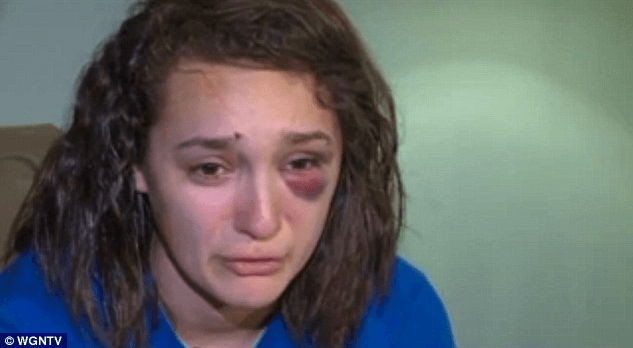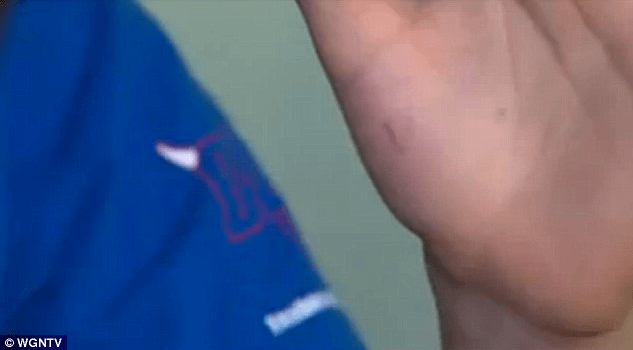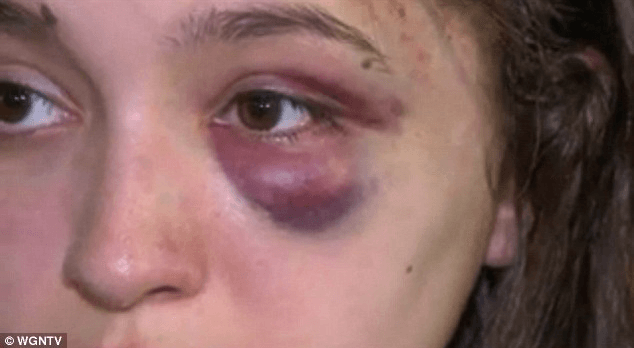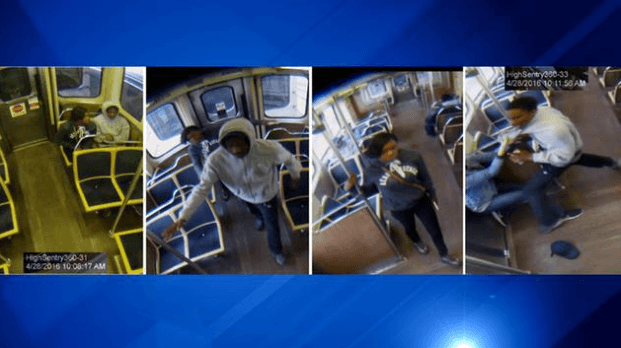Ricochet is the best place on the internet to discuss the issues of the day, either through commenting on posts or writing your own for our active and dynamic community in a fully moderated environment. In addition, the Ricochet Audio Network offers over 50 original podcasts with new episodes released every day.
 Chicago’s New Untouchables
Chicago’s New Untouchables
On April 28, 19-year-old Jessica Hughes, a DePaul University nursing student, was riding on a Chicago train, when:
After a large group of people got off the train at the UIC Halstead stop, a man moved to the seat in front of her, turned around and attacked.
“He grabs me, pushes me to the floor and starts beating on my head repeatedly,” Jessica said.
The man wanted Jessica’s phone. It was in her pocket. A woman who was with the attacker jumped in and punched Jessica in the nose, breaking it.
An awful story. A story repeated countless times on mass transportation systems in other major cities like New York and Washington DC. Here in DC, where I live, teenagers are being murdered, and groups of teens are attacking passengers on the Metro [Last month, I wrote an article detailing this for Ricochet]. In New York, stabbings, slashings, and assaults are such a problem that the New York Post recently wrote “Another day, another slashing.”
One detail about the Jessica Hughes beating is especially troublesome. No one helped:
“If you were seeing someone else getting abused, wouldn’t you want to step in?” Hughes said.
Hughes said that perhaps more painful than the beating she took at the hands of two robbers while riding the “L”, is that fellow passengers who saw the attack, did nothing to stop it.
“I was yelling for help. There were two other guys on the train and they did nothing. They just watched as he beat me,” she said.
WGN-TV interviewed Hughes, and show the broken nose, black eye, and teeth marks she got during her assault



Thankfully, Jessica will recover from her (physical) wounds, but:
A day later, the swollen and bruised teen says it will be tough to ride the train again as she struggles to understand why she was targeted.
Chicago Police released photos of the attack, and of the attackers:


They are still at-large.
Jessica Hughes isn’t the only person in Chicago recently attacked while no one tried to help.
This past Super Bowl Sunday, Marques Gaines, a 32-year-old bartender at a Chicago hotel, went to 7-Eleven, which would be the last thing he would ever do. The below video is graphic and hard to watch, but a record of exactly what happened to this innocent man.
If you would rather not watch it, know that Gaines was punched and knocked unconscious into a crosswalk outside the 7-Eleven. He laid there for minutes, while people approached him, only to rob him. Nobody stopped to help. Nobody dragged his motionless body out of the street. Minutes later, still in the crosswalk, a taxi ran him over.
On April 29, the day after Jessica Hughes was attacked, the Chicago Tribune reported that Gaines’ death was declared a homicide:
The death of a Magnificent Mile hotel bartender who died Super Bowl Sunday after being punched and then run over by a taxi as he lay unconscious in the street has been ruled a homicide, officials said Friday.
Marques Gaines, 32, died of multiple injuries from being run over by the taxi early on the morning of Feb. 7, but his death also was attributable to the assault that left him in the street, the Cook County medical examiner’s office said.
Gaines’ family had maintained from the beginning that they considered his death a homicide, and relatives were pleased with the medical examiner’s ruling, according to Drexina Nelson, Gaines’ first cousin.
Chicago doesn’t have a monopoly on people doing nothing to help others in need, but Chicago has an obvious problem. We need to ask ourselves why. Are people afraid of getting hurt themselves? There’s a good chance that the people who robbed and killed Jessica Hughes and Marques Gaines, would have killed or seriously injured anyone who tried to get involved. In Chicago, you most likely don’t have a gun to defend yourself. That always puts the odds in the attackers’ favor.
Or have we become so self-absorbed as a people that we have lost empathy and the ability to care for strangers in need? Are we too busy staring down at our smartphones, instead of surveying the world around us, aware of our increasingly dangerous surroundings.
Or are we simply afraid of lawsuits if we get involved? There was a recent story where a homeowner is being sued by the convicted burglar who shot him.
We also need to address the fact that attacks in Chicago happen in a city with arguably the strictest gun control measures in America. The vast majority of Chicago residents aren’t able to effectively arm themselves for self-protection. People who use mass transit in Chicago, and other Democrat-run cities with similar draconian gun control laws, are sitting ducks.
When the police can’t always be there to protect you, when you can’t carry a gun for self-defense, and when people will sit and watch as someone is assaulted or killed, how can you confidently walk the streets of Chicago, or use its mass transit? You can’t. This is a depressing and sobering reality of life in 2016 — in Chicago and in many places all around the country.
Hillary Clinton, who herself was born in Chicago, once said “It takes a village.” It seems that the “village” of Chicago is ignoring her advice, and there is a new generation of “Untouchables.”
Published in Guns, Policing



Agreed.
In these communities in the UK you can see every aspect of social breakdown that tends to be viewed as a racial issue here.
In my experience, yes. Though quite a few families that live in Austin break the rules and find a way to send their kids to the Oak Park schools.
I lived in the Austin neighborhood of Chicago until 1959. In a short period thereafter, Austin went from all white to all black. As I recall, the villiage elders across the city line in Oak Park devised a plan to integrate and maintain racial balance. I guess the plan worked.
Life at the Bottom by Theodore Daleymple is an excellent book that highlights this
Yep. And as already been pointed out on this thread by others, these areas have been run by liberal democrats for decades who have enacted layers and layers of liberal policies over those decades in control.
Oak Park prides itself on its commitment to diversity, but it’s fair to say that some areas of oak park are more diverse than others. Austin is now called the “murder capital” of Chicago.
We have some friends whose grandparents lived in Austin in the 50s but moved away to Boston. The Grandmom came to visit and wanted to go see the “old neighborhood” and was very surprised at the changes.
Why not, if the data are behind it? It’s not a “racialist snare” if it’s true.
This is, in fact, one of the tools taught in CPR training. The rescuer identifies a particular bystander, points to zim, and demands a 911 call. I did this while running a code in Newark’s Liberty Airport (May 18 2012–you don’t forget this sort of thing!) and had three other rescuers helping me in seconds.
Then the 911 police tried to arrest me, but that’s a story for another day.
Once again,no good deed goes unpunished.
Because what data can be gathered can only be a crude measure of the behavior of groups. What goes on in the heart of an individual can never be quantified or measured. This is the great error of the Left: they are most comfortable when thinking in terms of groups, races, classes, ethnicities, genders because humans are easy to figure out when you gather them up in a bunch. Regard them as they really are, as sovereign individuals and the difficulties begin. As well as possible solutions. It may be as simple as giving a beleaguered mom the wherewithal to pull her daughter from a failing school and place her in school where real learning is taking place. To think in terms of ‘data’ is to accept the divide that is opening up in our nation is unbridgeable save through state intervention. Been there, done that, saw the video last night on the news.
Maybe it exist already. An app that could place your 911 call by voice without having to take your phone in hand and switch apps. Because we a have so many of us wearing headphones or blue tooth devices just voicing “call 911” would save time and act on your first instinct and leave you with free hands to defend, aid or assist.
How about that in your next iteration of iOS Apple?
“
I remember the song and the story that went with it. The original report was that 38 people observed the stabbing and did nothing. Things are rarely quite as they appear. Even the Wikipedia article you linked points out that “…none saw or was aware of the entire incident.” Somehow, there’s an appeal to the myth of dozens of callous individuals who are oblivious to the problems of others. Yet the myth is repeated decades later. The Gell-Mann effect lives on.
My own experience is exactly the opposite, albeit on a far lesser scale than murder. When there’s an accident, I have seen people rush in to help and to call 911, if needed. Once I was thrown off my bicycle and was in too much pain to get off the pavement for a while. Someone blocked traffic, several people stopped to see if they could help, someone called 911 even though I said it wasn’t necessary. Several people stayed with me until I got up (~5 or 10 minutes) and paramedics arrived (maybe another 5 minutes).
I have observed similar behavior numerous other times. It’s moments like these that keep me from despair. People aren’t always good, e.g. the OP, but they’re not as bad as some would like to believe.
After one incident in which I ended up in bloody fisticuffs with someone who trespassed on my neighbor’s property, I said to my wife, “Well, I guess I answered that question.” She looked at me and said, “Did you really have any doubt? I never did.”
That made one of us.
I did the same thing years ago. The Italianate house I grew up in had become a seedy rooming house. Very depressing. But now it’s been fully restored and was recently sold to a local lawyer.
The question that comes to my mind; is Chicago ungovernable?
Jan. 1, 2016 – May 2, 2016 – 1,135 shooting victims
Jan. 1, 2015 – Dec. 31, 2015 – 2,988 shooting victims
The homicides don’t take into account the crimes that the essay brings to our attention.
As a sarcastic, cynical, and somewhat world weary former police officer I would suggest that instead of boycotting states that have tried to wrestle with the public restroom issue, you might find vacationing in North Carolina a much safer proposition than a trip to Chicago.
This happened to me once when I was in college. I was standing nearby as two young black men attacked an unarmed security guard (also black) at the entrance to a dormitory on campus. I froze in that moment and was later ashamed of myself for not doing anything. I will say that I was somewhat intoxicated (alcohol) at the time but I don’t know if that was a factor. Fortunately the security guard was able to grab a baseball bat nearby and chased the attackers away before they were able to hurt him seriously. The whole thing was over in less than a minute. Campus Police responded to a call but got there too late to apprehend the attackers.
I can only hope that if I am in a similar situation in the future I can react in a positive way and not freeze again.
Having been raised in abusive situations, and as a child unable to defend myself, I now respond to these types of things, In. A. Rage.
Safe or not, wise or not, I react with violence towards the attacker. I don’t even think about myself. I would have been on those two, screaming in rage, bashing their heads together with my purse, (pretty big and heavy). They would have been shocked at my attack and probably made a run for it. My thinking comes after its all over, “jeesh, what did you do that for? Dumb broad.” Fortunately, I haven’t had too many of these experiences as an adult.
The liberal answer is that the young lady should have surrendered her phone to these unfortunate victims of society and spared herself a beating. She has white privilege and thus can afford such things as phones while these others can not. Let’s be honest. Is a phone worth being beat up over?
Grrr.